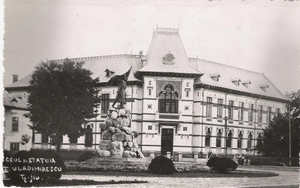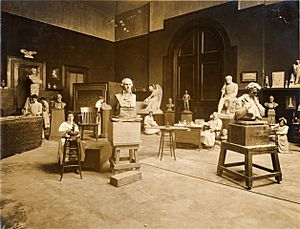George Julian Zolnay facts for kids
Quick facts for kids
George Julian Zolnay
|
|
|---|---|
 |
|
| Born | July 4, 1863 Bucharest, United Principalities of Moldavia and Wallachia
|
| Died | May 1, 1949 (aged 85) |
| Nationality | Romanian, Hungarian, American |
| Education | Karl Storck, William-Adolphe Bouguereau, Alexandre Falguière, Edmund von Hellmer, Carl Kundmann |
| Alma mater | Saint Sava National College Bucharest National University of Arts Academy of Fine Arts Vienna |
| Known for | sculpture |
George Julian Zolnay (born Gyula Zsolnay) was a famous sculptor. He was born on July 4, 1863, and passed away on May 1, 1949. He was from Romania and Hungary, and later became an American citizen. People often called him the "sculptor of the Confederacy" because of his many works in the Southern United States.
Contents
Early Life and Artistic Journey
George Julian Zolnay was born in Bucharest, Romania. His father, Ignác Zolnay, was from Pécs, Hungary. George first wanted to be a violin player and even got a scholarship for music. However, his father did not approve of this path.
Instead, George joined the Romanian cavalry for a short time when he was twenty. He enjoyed making models of military items and people. After leaving the military, he started working in civil service. But he also began to learn sculpting in his free time.
His father was very impressed by one of his sculptures. So, George went to study at the National School of Fine Arts in Bucharest. He then traveled to Paris, France, and later to the Imperial Academy of Fine Arts in Vienna. He earned a Grand Prix for his art, which is a very high award. This award also gave him money and his own art studio.
Becoming the "Sculptor of the Confederacy"
Zolnay came to the United States in 1893 to visit a big event called the World's Columbian Exposition. He planned to go back home, but he liked New York City so much that he decided to stay in 1894. He later became an American citizen.
In 1897, Zolnay became very popular in the Southern United States. He created a statue of Sam Davis, a spy for the Confederacy who was executed. Since there were no pictures of Sam Davis, Zolnay used Davis's family members to help him create the statue's face. Because of his many sculptures across the South, he earned the nickname "Sculptor of the Confederacy."
In 1898, Zolnay helped start the National Arts Club in New York City and became its first vice-president. He worked closely with Varina Davis, the widow of Jefferson Davis, who was the former President of the Confederacy. She even lent him her husband's clothes to help him make a very realistic statue of Jefferson Davis. This friendship helped Zolnay get many more sculpting jobs in the South, starting what was called his "Confederate Period" from 1899 to 1923.
Work in St. Louis and Washington, D.C.
In 1903, Zolnay moved to St. Louis, Missouri. He became the head of the sculpture department at the St. Louis School of Fine Arts. He taught many students there, including Caroline Risque and Nancy Coonsman. He also continued to create sculptures for various projects.
Zolnay was part of the team that planned the art for the 1904 Louisiana Purchase Exposition in St. Louis. He also made two large figures for the Transportation Building at the fair.
He and his team also created two huge lion and tiger statues. These eight-ton sculptures were placed on tall columns at the entrance to University City, Missouri.
In 1913, Zolnay moved his studios to Washington, D.C.. Besides sculpting and teaching art classes, he also gave talks about Romania at the Smithsonian Institution. He even helped illustrate a book about Romania.
Personal Life
George Zolnay married Abigail (Abbie) Rowan Gillim on November 23, 1902. She was from Kentucky. They had two daughters named Margaret and Elisabeth. Zolnay passed away in New York City on May 1, 1949.
Legacy and Famous Works

In 1902, Zolnay visited Romania and met with King Carol I of Romania at Peleș Castle. The King later gave Zolnay a special award called the Knight's Cross of the Order of the Crown.
Some of his important artworks in Romania include the statue of Tudor Vladimirescu in Târgu-Jiu and a bust of the poet Grigore Alexandrescu.
The Zolnay family, including George, greatly contributed to the culture of Pécs, Hungary. Their artworks can be seen all over the city, on buildings, roofs, sculptures, and more. George Zolnay himself made the sculpture of the Saracen boy that decorates a fountain there.
Notable Sculptures
- Figures for the Parthenon replica in Nashville, Tennessee, 1895.
- Jefferson Davis statue at Hollywood Cemetery in Richmond, Virginia, 1899.
- Angel of Grief memorial for Varina Anne "Winnie" Davis, also at Hollywood Cemetery, 1899.
- Confederate Monument in Owensboro, Kentucky, 1900.
- Two seated figures for the Transportation Building at the 1904 Louisiana Purchase Exposition in St. Louis.
- Nathaniel Parker Willis Monument in Crawfordsville, Indiana, 1909.
- Bronze Sam Davis Statue, known as the Boy Hero of the Confederacy, at the Tennessee State Capitol in Nashville, Tennessee, 1909.
- Confederate Private Monument in Centennial Park, Nashville, 1909.
- Barnard Monument at Buttonwood Park in New Bedford, Massachusetts, 1914.
- Bronze Pierre Laclède statue at City Hall in St. Louis, 1914.
- Memorial to the Confederate Dead in Forest Park, St. Louis, 1914 (removed in 2017).
- Frieze at Central High School (now Cardozo Senior High School) in Washington DC, 1916.
- Statue of Sequoyah for the National Statuary Hall Collection, 1917.
- Bronze bust of Edgar Allan Poe at the University of Virginia, Charlottesville, Virginia.
Images for kids
-
Zolnay statue at Jefferson Davis' gravesite in Richmond, Virginia.






